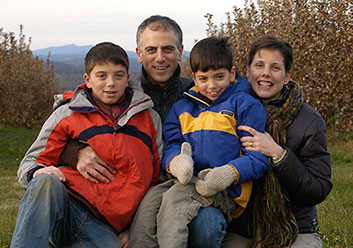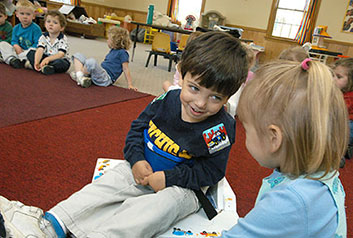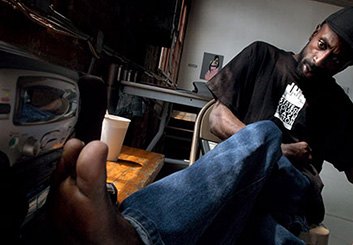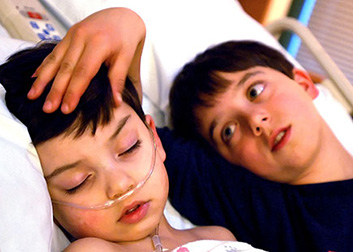Internal mini form
Contact Us Today

Photojournalist Dan Habib rarely thought about Inclusion, until his son was experiencing signs of disability. Now, with confirmed diagnosis, Dan thinks about inclusion most every day. Filmed over a four year period, Habbib provides a highly personal, but passionately filmed chronicle of the efforts his family made to include Samuel in everyday living. The documentary features four other individuals with disability, and provides interviews with teachers, peers, parents and disability rights experts.
Director: Dab Habib
Writers: Dan Habib
Based on: The true story of Samuel Habib
Starring: Samuel Habib, Keith Jones
Rating: Unrated
Genre: Documentary
Length: 90 minutes
Accolades: “Including Samuel” was screened at the Sprout Film Festival at the Metropolitan Museum of Art (NYC) and named “Best Documentary” at the Somewhat North of Boston Film Festival.
Released: 2008
Inclusion at home, school explored in father’s documentary
Samuel Habib is a child with beautiful dark eyes and an infectious smile. Like most children his age, he’s bright and curious, and anxious to assert independence. He loves his parents, and enjoys a special relationship with brother, Isaiah, who is three years older than he is.
Samuel has Cerebral Palsy, but that – his parents want others to know – is only a part of whom their son is. It’s that contention that is at the heart of “Including Samuel,” a documentary produced by Samuel’s father, Dan Habib, which asks fundamental questions all parents of a child with special needs must ask: How do parents foster a sense of belonging in the family, at school, and in society? How can parents make sure that they’re emotional cues benefit their child, and their siblings? And, in what can be an overwhelming schedule of appointments, health issues, and educational decisions, what lies ahead for their child, and their family?
The documentary, which is narrated by Dan, explores all of these questions through the prism of inclusion, especially when it comes to education. He interviews Samuel’s mother, Betsy McNamara, educators, and persons with physical, developmental and mental disabilities about their experiences with the education system in the United States.
“What if doctors told you that your child would live her life in an institution?” Dan asks. “What if your two kids could not go to the same school because one has autism? If your daughter retreated into an imaginary world inside her head, how would your life be different? How would your family change?
“How would you change if you had a son who needed a wheelchair?”

www.IncludingSamuel.com
The Habib family: from left, Isaiah, Dan, Samuel and Betsy. Photographed in October, 2007, in Concord, NH.
The path to “Including Samuel” began several years after Dan became a photojournalist. He was assigned a story about inclusion in regular classrooms for children with special needs, which was being piloted at Beaver Meadow School in Concord, NH, where his son now attends school.
Dan speaks honestly about his limited interactions with people with disabilities, especially when he was young. Save for one child, Dan doesn’t recall seeing any other children with disabilities when he was growing up in the 1970s. Dan didn’t have any trouble finding friends – he was like everyone else – and didn’t think much about inclusion, one way or the other. But as Samuel’s dad, he thinks about it every day.
Dan admits that after he learned Samuel had Cerebral Palsy, he was forced to admit he hadn’t always perceived people with disabilities to be as capable as he was. But he thought, what if the world thought of Samuel in that way?
To answer this question, Dan sought the perspectives of experts, educators and individuals with disabilities, including a man with Cerebral Palsy, the mother of a boy with autism and a young woman with schizophrenia that decided that, ultimately, inclusion was not for her.
Keith Jones, who has Cerebral Palsy and attended a school in St. Louis exclusively for students with disabilities in the 1970s, reflected on an educational system that he said did not encourage those with disabilities to reach their potential, and compared the environment to a nursing home.

www.IncludingSamuel.com
Samuel Habib, 3, sits in his supportive corner chair and smiles at a friend at school. Samuel, who has Cerebral Palsy, is a student in a typical preschool class in Concord, NH, at Shaker Road School. His parents, Dan Habib and Betsy McNamara are committed to full inclusion for Samuel in the community, family and at school.
“People really did not have high expectations for students with disabilities,” he said. “How the hell do I develop a positive self-image if from the time I get off the bus to the time I leave I am being told because of my physical presence, because of the physical conditions of my being, that I have to be secluded, stashed away, talked to in a demeaning manner, or talked to in a way where there’s no expectations about me doing anything. Then you want me to succeed? You want me to go out and be aggressive, be a product of society, and produce and put into this economy?”
When he was a teen, Keith’s family moved to Boston where, for the first time, he attended classes with able-bodied students, and the teachers didn’t speak to him in a condescending fashion. Keith said he found the experience empowering.
The documentary also explores what parents of children with disabilities experience, and the constant worries not only about their child’s health and welfare, but about how others will perceive – and treat – their children.
Betsy McNamara, Samuel’s mother, recalls when they first started realizing that Samuel might have a disability, she was afraid and mourned for all the aspirations you have for your child’s future.

www.IncludingSamuel.com
Keith P. Jones turns on a boom-box with his foot while teaching teenagers in a music and theater workshop in Boston. Jones, who has Cerebral Palsy, is a leading Boston disability rights activist and hip-hop artist. In “Including Samuel” he shares his educational experiences and toughts on the impact it had on his opportunities to be included in society as a whole.
“How could he run around on the playground and play kickball when he couldn’t run?” she asked. “How can he yack on the phone with his teenage friends when he has trouble talking? How could he get a full education and go to college when he can’t hold a pencil. I just couldn’t imagine beyond that, and I was very afraid for him, and for us.”
Samuel’s parents’ fears, even today, are grounded in reality. Christina Malfy, the mother of Alana, who attends public high school, recalled a discouraging experience at a high school event.
“We were at the awards ceremony for all of the athletes at school, they included all of the kids that did the Special Olympics,” she said. “And I heard from behind me somebody make a comment that was something along the lines of, ‘It doesn’t matter if you’re on the Special Olympics and you win, because you’re still retarded.

www.IncludingSamuel.com
Samuel Habib and his brother Isaiah Habib sit along Snow Pond in Concord, NH. Samuel watches his brother blow bubbles. “Including Samuel” explores the sibling relationship and bonds.
“It’s just amazing that those remarks could slide out of somebody’s mouth; somebody who was sitting a row away from me,” she said.
Both Dan and Betsy know they cannot change how people feel about their son, but their hope is that with inclusive policies in school and society that people begin to see Samuel in the way that he sees himself, and the way his family sees him – as an active, intelligent and engaged contribution to society, even though he is uniquely different than his peer.
“Including Samuel” also explores the loving relationship between Samuel and his brother Isaiah, who is three years his senior. But common amongst parents of children with special needs, Dan and Betsy also wonder if Samuel’s needs have taken attention away from Isaiah.

www.IncludingSamuel.com
Isaiah Habib (then 7), right, comforts his brother, Samuel Habib (then 4), in the intensive care unit of Mary Hitchcock Memorial Hospital. Samuel had recently come out of a medically induced coma. He had developed pneumonia after complications from a tonsillectomy.
The film explores, at its heart, what it means to be the parent of a child with special needs.
“For a long time, we would sit around after the kids went to bed and we’d compare notes on how Samuel did,” Betsy said. “He did better with this today, or he wasn’t as good with that today as he was the day before, and I realized that if I do everything that all of therapists and teachers suggest that I do then I’m working with him all the time on OT, on PT, on speech, on his education, on his stretching, and if you do all of those things every day, then I become his therapist, and not his mother. And I just want to be his mother.”
“Including Samuel” also explores the journey from constant worry, to acceptance, and yes, joy.
“We’ve finally figured out that constantly worrying about Samuel’s future isn’t the best way to be his parents,” Dan said. “We have to live in the present, look at who he is as a person, and his experience as our son, as Samuel, so that we can be his mom and dad.”
To learn more about “Including Samuel,” visit:
The documentary can be rented or owned. Ask your local movie rental or distributor, visit Amazon, or find purchase information, visit:

Of course parents already know their child’s journey is the stuff movies are made of, but as it turns out, there are several movies about individuals with Cerebral Palsy and how their condition has affected their lives. Here are some films that tell stories about inspiring people.





